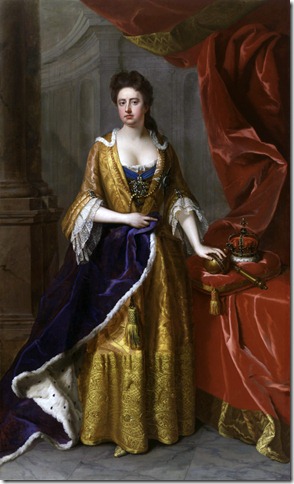
This is by no means an unusual occurrence since today there is known to be four 'Holy springs’ in the United Kingdom that are all named `St Ann’s Well.' The nearest of these is that situated in the Derbyshire town of Buxton that is of Roman origin, while there is also a local church in the town which bears the name of 'St. Anne's Church.' There is a St Ann’s Well at Stanwell a short distance from the main church their that is dedicated as `St Mary.' In St Helens, we find yet another St Ann’s Well In Berkshire, and there is a St. Anne's Well at Caversham.
Therefore a picture begins to emerge that these are all 'holy wells' or `sacred springs.' In fact, we also find such religious sites throughout Europe, especially in France, many of whom are dedicated to Saint Anne. This places us on the correct path for the origin of our own St Ann’s Well since it is also a religious site sanctified by the monks and their hermitage that existed here through the 15th & 17th centuries. In the bible the Saint herself is the mother of the Virgin Mary who gave birth to Jesus Christ at the dawn of Christianity.
St Anne enjoyed a renaissance during the 16th century throughout Europe and had risen to great popularity during the period of time that the `Oswell hermitage' was in regular use around the turn of the 16th century. It was therefore a step away from a form of dedication ceremony during which 'Oswell' became St Ann’s Well. The same occurrence that may have taken place a number of times throughout Britain over the years, if there was indeed such a ceremony.
 In my first St Ann’s book published in 1998 I suggested that King Henry-IV (1366-1413), shown here on the left, had performed the dedication, however, my historian colleagues have demonstrated to me that there are so few records that exist detailing the King's visits to Nottingham, let alone treks to Oswell situated upon his own land at The Coppice east of Nottingham Castle. There are records that do indeed show that King Henry-IV did visit Nottingham on a number of occasions, although none that are credible which state clearly the King dedicated 'Oswell' to that of Saint Anne. In addition this period of history was before the time of the Oswell hermitage itself, and our famous Well.
In my first St Ann’s book published in 1998 I suggested that King Henry-IV (1366-1413), shown here on the left, had performed the dedication, however, my historian colleagues have demonstrated to me that there are so few records that exist detailing the King's visits to Nottingham, let alone treks to Oswell situated upon his own land at The Coppice east of Nottingham Castle. There are records that do indeed show that King Henry-IV did visit Nottingham on a number of occasions, although none that are credible which state clearly the King dedicated 'Oswell' to that of Saint Anne. In addition this period of history was before the time of the Oswell hermitage itself, and our famous Well.
However, we do have Nottingham Corporation Records dating back to 1513, a century on from the eventual death of King Henry-IV. These refer to "Le [The] Hermitage," "Hermitage Wong," and "Hermitage Close." The early Nottingham Historian the Reverend John Orange referring to the period 1543-4 in which The Corporation Records were written, states —
"It is recorded that the sum of 3s 6d was paid to William Rose and his fellow for workmanship at Sainte An' Chappell."
The Rev. John Orange also gives another example —
"And a further sum of 2s to Deonyse Cowper for workmanship at Sainte An' Chappell. "
The Nottingham Mickleton Jury proceedings of 1577 give this account —
"Master Mayor, we desire you and your brethren that their may be a cover made at Sent Anne Well, as you and your brethren may desire as concerning, either at the chapel end or at some place convenient where you shall think good."
 There is a real Queen Anne of course, Queen Anne (Of England, Ireland, and Scotland) who reigned 1702 - 1714. Here there is a link between Queen Anne and Saint Anne since Saint Anne was the patron of pregnancy among others titles, and we know that the Queen herself had many problems in baring any children. There is also evidence of Queen Anne's visits to Nottingham Castle. The book `Through England on a Side Saddle in the time of William and Mary,' written by Celia Fiennes & published in 1888, has this passage —
There is a real Queen Anne of course, Queen Anne (Of England, Ireland, and Scotland) who reigned 1702 - 1714. Here there is a link between Queen Anne and Saint Anne since Saint Anne was the patron of pregnancy among others titles, and we know that the Queen herself had many problems in baring any children. There is also evidence of Queen Anne's visits to Nottingham Castle. The book `Through England on a Side Saddle in the time of William and Mary,' written by Celia Fiennes & published in 1888, has this passage —
“All the Streets are of a good size all about ye town and well pitch'd, there are several good houses in the town. There are 3 or 4 Large houses of the Duke of New-Castles with the Castle which is a fine thing-stands very high on a hill- and when you Come to the Castle you ascend 40 Steps to the Court and hall. The rooms are very Lofty and Large, 6 or 7 state rooms and a long gallery hung with fine Pictures of the family; the wanscoate is most of Cedar. Some Rooms are hung with good tapestry. The Chamber of State is hung with very Rich tapestry so much silver and gold in it that the 3 pieces that hung the Rome Cost 1500? : the bed was railed in as ye presence Chamber used to be, ye bed was damask. The floor of the room was inlayed with Cyphers and the Coronet: here ye Princess Ann Lay when she fled in King James's time when the prince of orange was Coming over.”
What is of great interest here is that Queen Anne, although persecuted at the latter half of her life, existed in the period of the St Anne hermitage, and the events that took place their when the site had transformed to become Blee's Farm (including the murder of Mrs Blee's farmhand John Clarke). However, the sacred spring was already being referred to as St Ann’s Well, and even Robin Hood's Well during the short period that pagan rituals were being performed here, usually on the annual Saint Anne's Day, 26 July.
Now let us return to the subject of Saint Anne herself, and to be honest not a lot is known about her within the pages of the bible. She is not mentioned in the New Testament, and we must depend on apocryphal literature, chiefly the Protoevangelium of James, which dates back only to the second century.
In the document we are told that, Anne, wife of Joachim, was advanced in years and that her prayers for a child had not been answered. Once, as she prayed beneath a laurel tree near her home in Galilee, an angel appeared and said to her, "Anne, the Lord hath heard thy prayer and thou shall conceive and bring forth, and thy seed shall be spoken of in all the world." Anne replied, "As the Lord my God giveth, if I beget either male or female, I will bring it as a gift to the Lord my God; and it shall minister to Him in holy things all the days of its life." Thus, Anne became the mother of the Blessed Virgin Mary.
The devotion of St. Anne was known in the East in the fifth century, but it was not diffused in the West until the thirteenth. A shrine at Douai, in northern France, was one of the early centres of the devotion. In 1382, her feast was extended to the whole Western Church, and she became very popular, especially in France. Her two most famous shrines are at St. Anne d'Auray in Brittany and at St. Anne-de Beaupre in the province of Quebec.
She is patroness of `Lace workers,' among other things, a fact I found of great interest in relation to Nottingham, and our inner city area of St Ann’s itself. Her emblem is a door. St. Anne has been frequently represented in art, and the lovely face depicted by Leonardo da Vinci comes first to mind in this connection. The name Anne derives from the Hebrew Hannah, meaning "grace."
Probably the best internet site that describes Saint Anne is 'The Patron Saints Index', this describes Saint Anne in these terms—
"Mother of Our Lady. Grandmother of Jesus Christ. Wife of Saint Joachim. Probably well off Tradition says that Anne was quite elderly when Mary was born, and that she was their only child. The Vatican condemned the belief that Anne remained a virgin in the conception and birth of Mary in 1677. Believed to have given Mary to the service of the Temple when the girl was three years old. Devotion to her has been popular in the East from the very early days of the Church; widespread devotion in the West began in the 16th century, but many shrines have developed since.
"Canonized cult extended to the whole Church in 1584; Name Meaning gracious one; grace (Anne).
"Patronage: Adjuntas, Puerto Rico; against poverty; Brittany; broom makers; cabinet makers; Canada; carpenters childless people; archdiocese of Detroit, Michigan; equestrians; France; grandmothers; grandparents; homemakers; horse men; horse women; housewives lace makers; lace workers; lost articles; miners; mothers; diocese of Norwich, Connecticut, old-clothes dealers; poverty,, pregnancy, pregnant women; Quebec; Santa Ana Indian Pueblo, riders; seamstresses; stablemen; sterility; Taos New Mexico; turners; women in labour."
 In conclusion our inner city area of Nottingham, St Ann’s originates from the religious dedication of the Monastery or Hermitage to Saint Anne from about the year 1540. With the spring attracting many visitors, and therefore increasing the popularity of the monastery grounds, it made good sense for the monks or hermits their to refer to it as a holy well or sacred spring, and they adopted it along with their religious monastery, and from this point onward it soon became known as Saint Anne's Well. The name of our inner city area of Nottingham soon followed - St. Anne's.
In conclusion our inner city area of Nottingham, St Ann’s originates from the religious dedication of the Monastery or Hermitage to Saint Anne from about the year 1540. With the spring attracting many visitors, and therefore increasing the popularity of the monastery grounds, it made good sense for the monks or hermits their to refer to it as a holy well or sacred spring, and they adopted it along with their religious monastery, and from this point onward it soon became known as Saint Anne's Well. The name of our inner city area of Nottingham soon followed - St. Anne's.
No comments:
Post a Comment